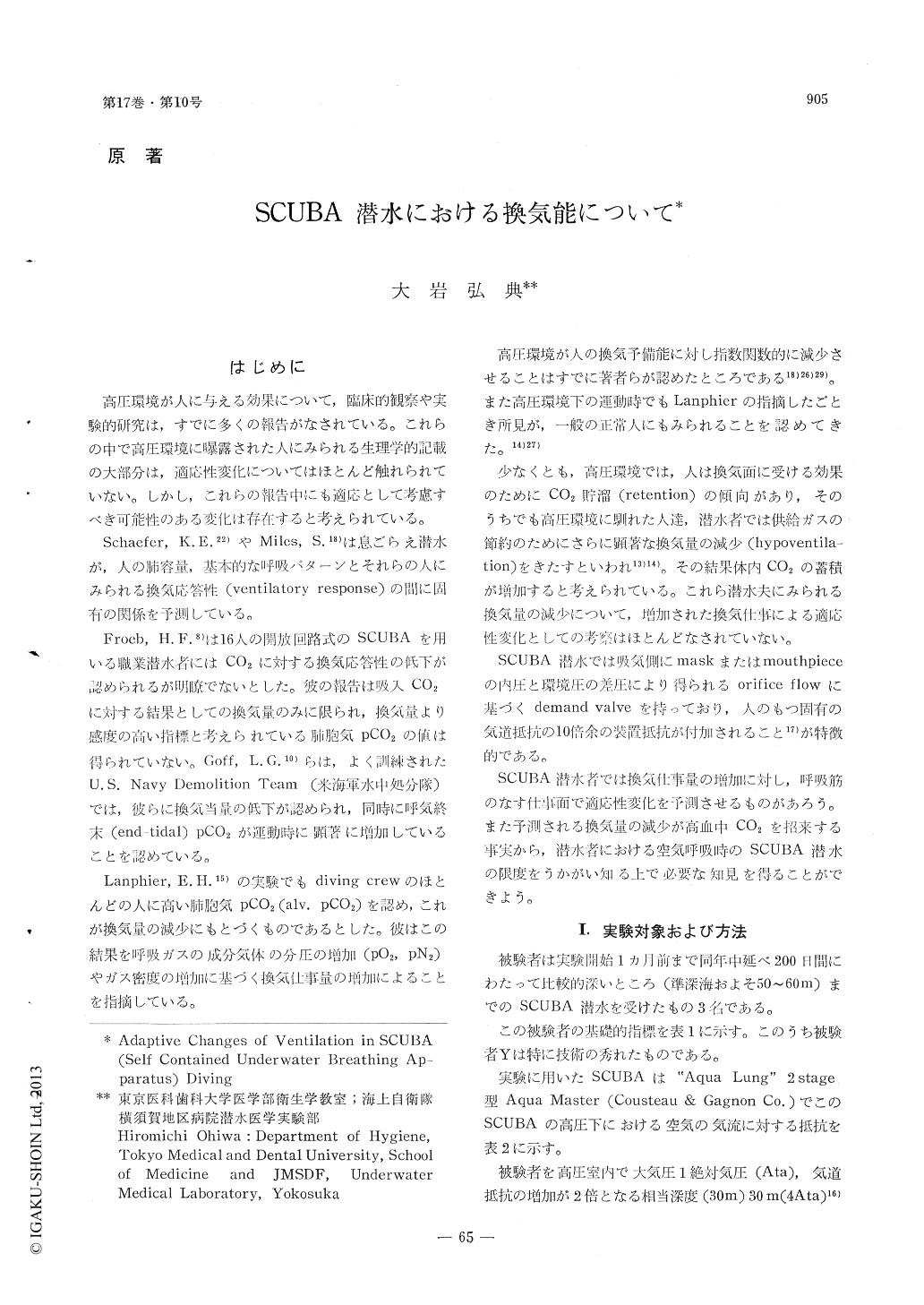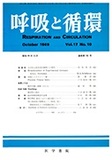Japanese
English
- 有料閲覧
- Abstract 文献概要
- 1ページ目 Look Inside
はじめに
高圧環境が人に与える効果について,臨床的観察や実験的研究は,すでに多くの報告がなされている。これらの中で高圧環境に曝露された人にみられる生理学的記載の大部分は,適応性変化についてはほとんど触れられていない。しかし,これらの報告中にも適応として考慮すべき可能性のある変化は存在すると考えられている。
Schaefer, K. E. 22)やMiles, S. 18)は息ごらえ潜水が,人の肺容量,基本的な呼吸パターンとそれらの人にみられる換気応答性(ventilatory response)の間に固有の関係を予測している。
Froeb, H. F. 8)は16人の開放回路式のSCUBAを用いる職業潜水者にはCO2に対する換気応答性の低下が認められるが明瞭でないとした。彼の報告は吸入CO2に対する結果としての換気量のみに限られ,換気量より感度の高い指標と考えられている肺胞気pCO2の値は得られていない。Goff, L. G. 10)らは,よく訓練されたU. S. Navy Demolition Team(米海軍水中処分隊)では,彼らに換気当量の低下が認められ,同時に呼気終末(end-tidal)pCO2が運動時に顕著に増加していることを認めている。
Lanphier, E. H. 15)の実験でもdiving crewのほとんどの人に高い肺胞気pCO2(alv.pCO2)を認め,これが換気量の減少にもづくものであるとした。彼はこの結果を呼吸ガスの成分気体の分圧の増加(pO2,pN2)やガス密度の増加に基づく換気仕事量の増加によることを指摘している。
高圧環境が人の換気予備能に対し指数関数的に減少させることはすでに著者らが認めたところである18)26)29)。また高圧環境下の運動時でもLanphierの指摘したごとき所見が,一般の正常人にもみられることを認めてきた。14)27)
少なくとも,高圧環境では,人は換気面に受ける効果のためにCO2貯溜(retention)の傾向があり,そのうちでも高圧環境に馴れた人達,潜水者では供給ガスの節約のためにさらに顕著な換気量の減少(hypoventila—tion)をきたすといわれ13)14)。その結果体内CO2の蓄積が増加すると考えられている。これら潜水夫にみられる換気量の減少について,増加された換気仕事による適応性変化としての考察はほとんどなされていない。
SCUBA潜水では吸気側にmaskまたはmouthpieceの内圧と環境圧の差圧により得られるorifice flowに基づくdemand valveを持っており,人のもつ固有の気道抵抗の10倍余の装置抵抗が付加されること17)が特徴的である。
SCUBA潜水者では換気仕事量の増加に対し,呼吸筋のなす仕事面で適応性変化を予測させるものがあろう。また予測される換気量の減少が高血中CO2を招来する事実から,潜水者における空気呼吸時のSCUBA潜水の限度をうかがい知る上で必要な知見を得ることができよう。
In an open circuit SCUBA diving, the flow resistance of the equipment increases more than ten times of the resistance without equipment, and accordingly the breathing work increases in proportion to the increase of the viscous resistance. At the same time, the hypoventilation is observed.
To study this hypoventilation in diving as a phenomenon of the adaptive changes from the standpoint of the ventilatory mechanics, the author carried out the following experi-mental work.
The subjects, three well trained profes-sional SCUBA divers, having nearly the same predicted pulmonary functions, were exposed to the simulated depths of 0 m (sea level), 30 m (the air way resistance is two times larger than that at 0 m) and 50 m in a hy-perbaric chamber. There, at each depth, they were subjected by a light exercise (60 kg.m by a bicycle ergometer-RMR=1. 5-equivalent to an underwater swimming speed only by kicking with fins of 25 m/min) in 5 minutes.
In SCUBA diving, the significant decrease of the minute respiratory volume was observ-ed because of the decrease of the respiratory rate. In this case, it might be considered that the decrease of the alveolar ventilation (VA) is also due to that of the respiratory rate, as the alveolar volume (VA) is almost constant.
It was clearly recognized that the high alv. Pco2 was accompanied with the decrease of the oxygen equivalent. This tendency was also more manifest at the SCUBA diving compared with the cases of the other diving systems. In this case, a decrease of the ventilatory response to CO2 was observed in these three subjects.
Also the CO2 output decreased by the dec-rease of VA with the increase of the depth. Accordingly it might be assumed that there is a tendency of the CO2 accumulation in the body under hyperbaric environment.
The most characteristic phenomenon in this experiment was the slight increase or rather the decrease of the CO2 uptake during the SCUBA diving with a large ventilatory resistance by this equipment compared with the cases of the other diving systems.
It might be due to an adaptive change in the well trained divers, as they can restrict the breathing work in a lower level against the estimated increase of the breathing work under a pressure in question.
To acquire the minimum alveolar ventila-tion, the respiraory rate decreased instead of the tidal volume, as the decrease of the ventilatory rate minimizes the breathing work. The resulted decrease of the flow rate is not so influenced by the high atmos-pheric pressure, and the elastic resistance becomes more dominant than the nonelastic ones such as the viscous resistance.
This decrease of the respiratory rate shows the most optimum rate from the standpoint of the breathing work.

Copyright © 1969, Igaku-Shoin Ltd. All rights reserved.


